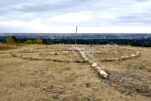Eye on the Esplanade: The Inner Workings: All stories are important
By Medicine Hat News on July 13, 2018.
The Theban Necropolis, Egypt, 1922. After years of searching through sand and rock, a man stands at the bottom of set of stone stairs leading into the mountainside. His time has come. Chisel in hand, he makes a small hole in the sealed doorway. With the light of a candle he peers through the hole as another man asks him, “Can you see anything?” He replies, “Yes! Wonderful things!” Howard Carter, Lord Carnarvon, and their team had discovered tomb KV62 in the Valley of the Kings; the tomb of the young Pharaoh Tutankhamun. The tomb has become one of the most famous archaeological sites in the world. Egypt’s dry climate and the stable microenvironment of the tomb had preserved more than 5,000 artifacts, many of them made of gold and other precious materials. The search for Egypt’s treasures, always popular, increased and over the years many important artifacts were found. Some were sold onto the foreign collector’s market (now illegal) and some remained in Egypt. The Egyptian government opened the first small museum in Cairo in 1835 to house a growing collection of artifacts. By 1902 the collection had out-grown two more museums and the Museum of Egyptian Antiquities was established in Tahrir Square in Cairo. Egyptology and archaeology continued to be popular throughout the 20th century, and the collections grew. There are hundreds of thousands, if not millions of artifacts in collections in Egypt. Millions of artifacts need a lot of research, restoration, and interpretation. To care for these collections, the Egyptian government began developing a new museum in 2002. The Grand Egyptian Museum sits two kilometres northwest of the Pyramids on the Giza plateau and is due to open later this year. It will exhibit more than 120,000 artifacts, including — for the first time — the entire collection from Tutankhamun’s tomb. It will have 880,000 square feet of exhibit space (the Esplanade has about 8,000)! Earlier this year I was invited to present at the fourth annual Tutankhamun Conference in Cairo. This conference was developed to seek information on how best to interpret and exhibit the items from Tutankhamun’s tomb. In early May I took a leave of absence from work and travelled to Egypt to speak on the research I had done on a coat of armour from Tutankhamun’s tomb. It was a wonderful opportunity and an honour to participate in the interpretation of such an important collection. I can hear some of you asking yourselves, “What does this have to do with the Esplanade?” Well, every time I travel to Egypt I am struck with how important Egypt’s history is to the country and how proud the people are of their heritage. It reminds me of how important our own heritage is here in Alberta. Our collection at the Esplanade has a lot of common everyday items. So does the Grand Egyptian Museum. They have vastly more artifacts than we do, and more than a hundred times the exhibit space, but the stories that will be interpreted in the new Grand Egyptian Museum are really no different that the stories we have in the Esplanade. There are the stories of life, of love, of living, the lives of the great and the small. The stories of politicians, farmers, builders, and doctors are all on exhibit there, and so are a thousand others. There is more than 10,000 years of human history in the Nile Valley. Human habitation in Alberta is just as old. People have walked in both places, living their lives, leaving their mark on the landscape. Both places have wonderful history and interesting stories. I would imagine that most of the people of Medicine Hat would recognize the golden funeral mask of Tutankhamun and know some stories about Egypt. We need to recognize our history and know our own stories, too. We should never underestimate the importance of our own stories. Our history is every bit as important as that of ancient Egypt — even if we do have fewer pyramids. Thomas Hulit is a museum technician at the Esplanade. 9-8




